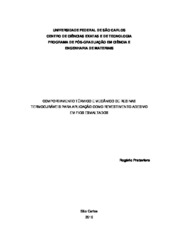Comportamento térmico e mecânico de resinas termocuráveis para aplicação como revestimento adesivo em fios esmaltados
Abstract
Selfbonding magnet wires are composed by two or more polymeric cover layers, being the inner layers thermosetting and the over coat composed of a thermoplastic cross-linkable layer. These wires are used in several magnetic wire coil applications, such as TV deflecting coils, coils for small motors, electrical coils for automotive, coil speakers, etc. In general, the bondable layer is activated by heating, joining the turns irreversible, even when heated to high temperatures or exposed to solvents. During this procedure the material change from a thermoplastic one to a thermosetting material, being of great importance the study of properties such as glass transition temperature and viscosity behaviour. It was used a cross-linkable polyester resin and a single component epoxy resin in this work. These materials were characterized by thermogravimetry analysis (TGA), thermo-mechanical analysis (TMA), differential scanning calorimetry (DSC) and infrared spectroscopy (FTIR). It was possible to evaluate the effects of residual solvent and the crosslinking of the materials by the thermomecanical response of TMA, from which it was determined the glass transition temperature (Tg). This transition was affected by the residual solvent and the curves after Tg shows a second transition which was attributes to softening temperature associated with the crosslink degree of the materials. It was possible to quantify the loss of residual solvent of the polymer in each cycle of TMA by TGA. DSC make it possible to study the kinetics of cure of epoxy resin which shows a polymerization kinetic of order n = 1,2 and an average activation energy of 120 KJ/mol.
